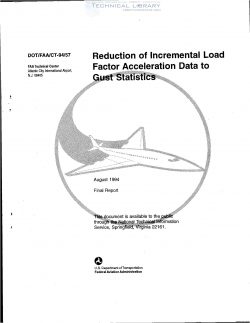DOT-FAA-CT-94-57
- Version
- 139 Downloads
- 2.92 MB File Size
- 1 File Count
- May 10, 2017 Create Date
- May 10, 2017 Last Updated
Reduction of Incremental Load Factor Acceleration Data to Gust Statistics

As part of the research program on aging aircraft, the Federal Aviation
Administration (FAA) has started an ambitious program on flight loads. A large
number of transport aircraft will be equipped with multiparameter recording
devices to collect statistical data on aircraft loads in actual service
conditions.
The Netherlands Civil Aviation Department (RLD) and the FAA have signed a
memorandum of cooperation in the area of aircraft structural integrity, with
specific reference to aging aircraft. As part of this cooperation, the National
Aerospace Laboratory (NLR) was contracted to participate in the flight loads
program. One of the tasks specified is the acquisition and review of European
sources of flight load data and the reduction of these data into gust statistics
using a unified reduction procedure. This data reduction procedure should be
compatible with the analysis format to be applied to the data acquired in the
current FAA flight load recording program. This report describes the procedures
proposed for the reduction of cenger of gravity {vergjcal acceleration dataU
gust statistics.
In the development of these procedures, it will be generally assumed that a
continuously recorded aCCeleration time trace is available for analysis,
accompanied by additional data on speed, altitude, weight, aircraft
configuration, etc. Specific aspects treated successively include:
a. The separation of accelerations due to gusts and maneuvers.
b. The definition of peaks and valleys in the acceleration trace.
c. The reduction of An peaks/valleys to gust velocities.
It will be proposed to simultaneously apply two reduction techniques: one based
on a discrete gust model using the so—called Pratt formula and the other based on
a continuous PSD—gust model.
Much of existing old load data bases for the most part are available only in a
very reduced format. Methods to reevaluate this data will be discussed in section
6, with specific reference to the acquired European data sources, namely NLR
Boeing 747 ACMS data, ONERA—high load data, and RAE fatiguemeter data.
The report concludes with a summary of proposed data reduction and analysis
procedures.
| File | Action |
|---|---|
| DOT-FAA-CT-94-57 Reduction of Incremental Load Factor Acceleration Data to Gust Statistics.pdf | Download |
Comment On This Post